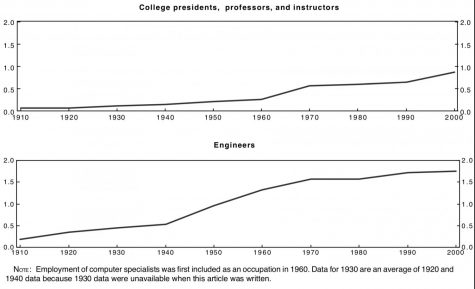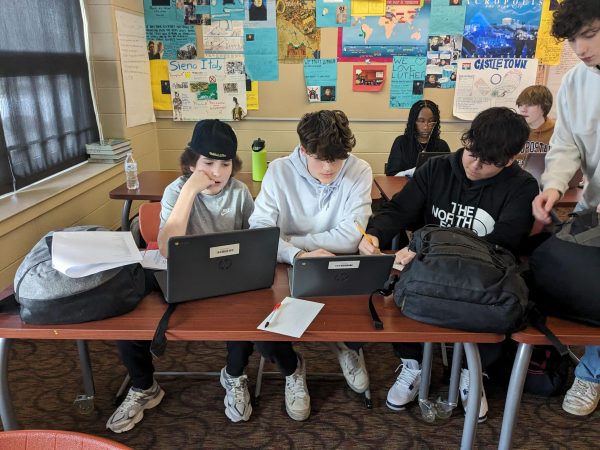Classrooms Then and Now
March 15, 2019
Classic Configuration and Now
World War One occurred from 1914 to 1918, approximately 100 years ago. At that time, classrooms contained the typical blackboard in the back with the teacher’s desk at the front. The desks were often elevated with teachers sitting in a tall chair, so that they may watch the students at their desks. Teachers’ desks at Waterford are usually in a corner of the room, and the school has adopted the use of whiteboards and smartboards. However, the idea behind a whiteboard is essentially the same as the one behind a blackboard. Smartboards, on the other hand, give access to lots of resources very easily.
Throughout the Century
The need for higher education was brought on by new job opportunities present after World War II. The military was no longer the same market for jobs and the nation did not need as many people in factories to produce weapons. Therefore jobs that required education formed, and secondary school education received a new purpose: to prepare students for college. For example, both college careers and engineers became a larger percentage of the workforce. In parallel to those trends, a 2017 statistical analysis shows the percentage of the American male and female population that carried a 4-year degree rose from 5.5% and 3.8% in 1940 to 33.7% and 34.6% in 2017. throughout the century as displayed in the data below from the Bureau of Labor Statistics.
Our own Ms. Jacaruso attended high school at St. Bernard’s from 1957 to 1961 and her experience differed from the modern experience. The greatest difference she noted was the strictness exhibited in the late 50s and early 60s. Ms. Jacaruso described having only Latin and French for world language and “reading, writing, and arithmetic was how it was” for the rest. Preparing for college was the single goal of education with little provided in terms of job experience or other career paths.
Socially speaking, St. Bernard’s enforced the separation of the sexes. Ms. Jacaruso explains, “When boys came in a year after… we weren’t allowed to interact with them”. Any talking or interaction with males was discouraged by the adults at school. Additionally, the girls had to always sit properly without crossing their legs. One of the most striking aspects of the classroom at St.Bernard’s is the organization of student seating. While students with IED and special needs receive preferential seating, Ms. Jacaruso’s class was arranged by the grade they had in the class where the students with the highest grades would sit up front and the lower grades farther back.
Change
Advancements in technology are the most obvious and large-scale changes, which according to Mr. Cadorette have made “education more efficient, not exactly better”. The ease of access to information and resources make learning easier, but education is “human and they provide more variables.” For instance, students currently learn through an array of methods while Mr. Cadorette’s father learned mainly “by rote memorization.” However, Mr. Cadorette has observed that even with the change in method, “there is no more hunger to learn.” Whatever betterment there has been in education has more to do with teachers. Teachers now are paid more, which allows the job to be considered more professional – leading to accountability. A notable difference in education now from 1971 is the abundance of opportunities for students to act like adults. In Mr. Cadorette’s experience during the late 70s and early 80s, teachers were “always right and whatever they said was written in stone”. Now, there is more “us and them” between teachers and students where teachers can have intelligent conversations with students without a lesson plan and “any professional teacher knows to maintain that.”
In essence, education has grown larger and less strict and more efficient with technological advancements and evolving student-teacher dynamics. There has been a rise in educational interest and an expansion of the resources present as the century went by while socially, the classroom became looser about its rules and treatment of education. It is important to consider the progress made by our education nationally, as it can help to understand how it may change in the future and what changes area progress forwards or backwards.













